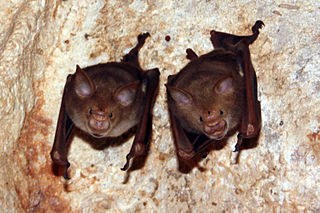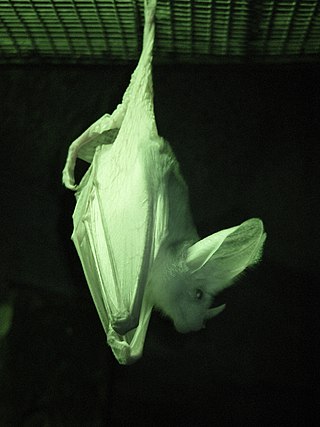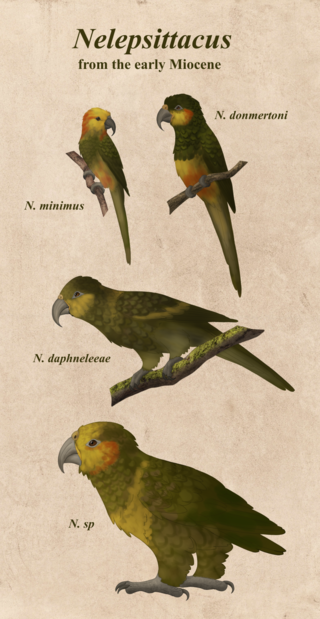
The New Zealand wrens are a family (Acanthisittidae) of tiny passerines endemic to New Zealand. They were represented by seven Holocene species in four or five genera, although only two species in two genera survive today. They are understood to form a distinct lineage within the passerines, but authorities differ on their assignment to the oscines or suboscines. More recent studies suggest that they form a third, most ancient, suborder Acanthisitti and have no living close relatives at all. They are called "wrens" because of similarities in appearance and behaviour to the true wrens (Troglodytidae) but are not members of that family.

The biodiversity of New Zealand, a large island country located in the south-western Pacific Ocean, is varied and distinctive. The species of New Zealand accumulated over many millions of years as lineages evolved in the local circumstances. New Zealand's pre-human biodiversity exhibited high levels of species endemism, but has experienced episodes of biological turnover. Global extinction approximately 65 Ma resulted in the loss of fauna such as non-avian dinosaurs, pterosaurs and marine reptiles e.g. mosasaurs, elasmosaurs and plesiosaurs. The ancient fauna is not well known, but at least one species of terrestrial mammal existed in New Zealand around 19 Ma. For at least several million years before the arrival of humans, the islands had no terrestrial mammals except for bats and seals, the main component of the terrestrial fauna being insects and birds. It was not until the 14th century that new species were introduced by humans.

Mystacinidae is a family of unusual bats, the New Zealand short-tailed bats. There is one living genus, Mystacina, with two species, one of which could have possibly become extinct in the 1960s. They are medium-sized bats, about 6 centimetres (2.4 in) in length, with grey, velvety fur.

The New Zealand lesser short-tailed bat is a small-sized omnivorous mammal endemic to the islands of New Zealand. It is one of two extant and three overall terrestrial mammal species unique to New Zealand. Its closest relative, the New Zealand greater short-tailed bat, was last seen in 1965 and is presumed extinct due to intense predation from ship rats introduced in the last few centuries. These bats are also commonly referred to as pekapeka, their Māori-language name. Lesser short-tailed bats have unique adaptations that differentiate them from bats found in other parts of the world. For example, they are fully capable of moving along the ground to search for food, and the males sing to attract partners, taking turns to do so. Lesser short-tailed bats are a vulnerable species, so extensive conservation work and research are being done to prevent extinction.

The Hipposideridae are a family of bats commonly known as the Old World leaf-nosed bats. While it has often been seen as a subfamily, Hipposiderinae, of the family Rhinolophidae, it is now more generally classified as its own family. Nevertheless, it is most closely related to Rhinolophidae within the suborder Yinpterochiroptera.
The Saint Bathans mammal is a currently unnamed extinct primitive mammal from the Early Miocene of New Zealand. A member of the Saint Bathans fauna, it is notable for being a late-surviving "archaic" mammal species, neither a placental nor a marsupial. It also provides evidence that flightless fully terrestrial mammals did in fact once live in Zealandia. This is in contrast to modern New Zealand, where bats, cetaceans and seals are the only non-introduced mammals in the otherwise bird-dominated faunas.

Prior to human settlement, the mammals of New Zealand consisted entirely of several species of bat and several dozen marine mammal species. Far earlier, during the Miocene, at least one "archaic" terrestrial mammal species is known to have existed, the Saint Bathans mammal. The Māori brought the kurī and kiore in about 1250 CE, and Europeans from 1769 onwards brought the pig, mice, two additional species of rats, weasels, stoats, ferrets and possums and many other species, some of which cause conservation problems for indigenous species.

Macroderma is a genus of microbats, present in the fossil record and as one extant species. They have existed in Australia since the early Miocene.

Nelepsittacus is a genus of extinct New Zealand parrots that is closely related to the genus Nestor. It consists of four species, of which three have been named so far. The species are all known from the early Miocene Saint Bathans Fauna from the Lower Bannockburn Formation in Otago in New Zealand.

The St Bathans fauna is found in the lower Bannockburn Formation of the Manuherikia Group of Central Otago, in the South Island of New Zealand. It comprises a suite of fossilised prehistoric animals from the late Early Miocene (Altonian) period, with an age range of 19–16 million years ago.
Miotadorna is a genus of extinct tadornine ducks from the Miocene of New Zealand. It contains two species, M. sanctibathansi, and M. catrionae.

The Manuherikia Group is a fluvial-lacustrine sedimentary fill in the Central Otago area of New Zealand, at the site of the prehistoric Lake Manuherikia. The area consists of a valley and ridge topography, with a series of schist-greywacke mountains at roughly ninety degrees to each other. The Manuherika Group occurs in the current basins, and occasionally on the mountains themselves.
Vulcanops jennyworthyae is an extinct species of bat that lived during the Miocene in New Zealand, a large burrowing microchiropteran that probably ate arthropods and plant material around twenty million years before present. It is the type and only described species of the genus Vulcanops.
Rhinonicteris tedfordi is an extinct species of microbat, of the order Chiroptera, known from fossil material found in Australia.

Rhinonycteridae is a family of bats, within the suborder Yinpterochiroptera. The type species, the orange nose-leafed species group Rhinonicteris aurantia, is found across the north of Australia.
Suzanne J. Hand is Professor Emeritus at the University of New South Wales, a teacher of geology and biology, who has a special interest in vertebrate palaeontology and modern mammals. Her research has been published in over 250 articles and books, and is especially focused on the subjects of evolutionary biology, functional morphology, phylogenetics, and biogeography. Hand is a co-leader of the research team investigating the Riversleigh World Heritage Area, regarded as one of the four most important sites of fossil-bearing formations in the world.
Xenorhinos is a genus of bat that existed in the early Miocene. It was discovered at a fossil deposit of the Riversleigh World Heritage Area in the north of Australia. There are two known species, Xenorhinos halli and X. bhatnagari.
Hipposideros winsburyorum is a hipposiderid species of bat known by fossil specimens, one of the many new taxa of chiropterans discovered in the Riversleigh World Heritage Area. The species existed during the Pliocene.

Heracles inexpectatus is a giant fossil parrot species from New Zealand, assigned to a monotypic genus Heracles, that lived during the early Miocene approximately 16 to 19 million years ago. The species was described from two tibiotarsus fossils discovered in 2008 at Saint Bathans, Otago, New Zealand. It is believed that the species stood up to 90 cm tall and weighed approximately 7 kg (15 lb). Initial analysis suggests that this parrot is from the order Psittaciformes and from the superfamily Strigopoidea, which consists of three confirmed primitive genera of parrots: Nestor, Strigops (Kākāpō) and the fossil Nelepsittacus. It may have been the ancestor of the kākāpō.

Noctilionoidea is a superfamily of bats containing seven families: Thyropteridae, Furipteridae, Noctilionidae, Mormoopidae, Phyllostomidae, Myzopodidae, and Mystacinidae.












